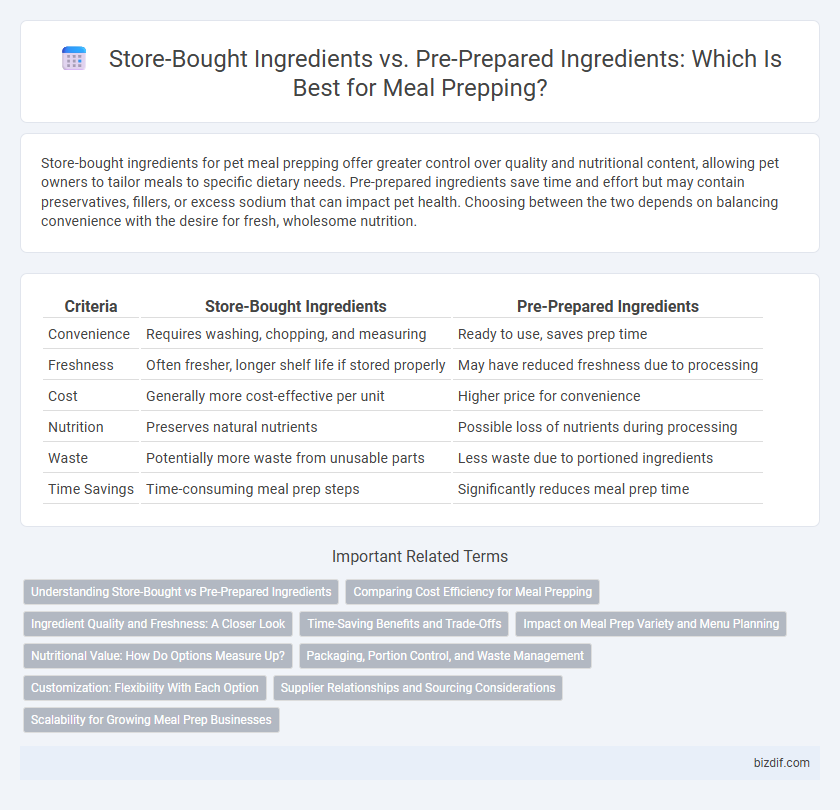Store-bought ingredients for pet meal prepping offer greater control over quality and nutritional content, allowing pet owners to tailor meals to specific dietary needs. Pre-prepared ingredients save time and effort but may contain preservatives, fillers, or excess sodium that can impact pet health. Choosing between the two depends on balancing convenience with the desire for fresh, wholesome nutrition.
Table of Comparison
| Criteria | Store-Bought Ingredients | Pre-Prepared Ingredients |
|---|---|---|
| Convenience | Requires washing, chopping, and measuring | Ready to use, saves prep time |
| Freshness | Often fresher, longer shelf life if stored properly | May have reduced freshness due to processing |
| Cost | Generally more cost-effective per unit | Higher price for convenience |
| Nutrition | Preserves natural nutrients | Possible loss of nutrients during processing |
| Waste | Potentially more waste from unusable parts | Less waste due to portioned ingredients |
| Time Savings | Time-consuming meal prep steps | Significantly reduces meal prep time |
Understanding Store-Bought vs Pre-Prepared Ingredients
Store-bought ingredients typically offer fresher options with more control over nutritional content and portion sizes, making them ideal for customized meal prepping. Pre-prepared ingredients save time and reduce cooking effort but may contain added preservatives, sodium, or sugars that can affect meal quality and health benefits. Evaluating the balance between convenience and nutritional value helps optimize meal prepping strategies for both health and efficiency.
Comparing Cost Efficiency for Meal Prepping
Store-bought ingredients generally offer greater cost efficiency for meal prepping due to lower prices per unit and bulk purchasing options. Pre-prepared ingredients often carry premium pricing because of added convenience and labor costs, which can quickly increase overall meal prep expenses. Selecting whole, fresh items and preparing them yourself maximizes value while allowing customization and reducing food waste.
Ingredient Quality and Freshness: A Closer Look
Store-bought ingredients often offer higher quality and freshness, essential for nutrient retention and flavor in meal prepping. Pre-prepared ingredients may contain preservatives and have reduced freshness, impacting taste and nutritional value. Choosing fresh, store-bought produce and proteins enhances meal quality and supports healthier eating habits.
Time-Saving Benefits and Trade-Offs
Store-bought ingredients offer fresh flavors and control over meal nutrition but require more preparation time, which can slow down meal prepping schedules. Pre-prepared ingredients significantly reduce cooking time by eliminating chopping and portioning steps, ideal for busy individuals seeking convenience. However, trade-offs include higher costs, potential preservatives, and less customization in meals using pre-prepared components.
Impact on Meal Prep Variety and Menu Planning
Store-bought ingredients provide greater flexibility in meal prepping, enabling a diverse range of recipes and personalized menu planning based on dietary preferences and nutritional goals. Pre-prepared ingredients, while saving time, often limit variety due to standardized portions and predetermined seasoning, which may restrict customization. Balancing fresh and pre-prepared components enhances meal prep efficiency without compromising on menu diversity.
Nutritional Value: How Do Options Measure Up?
Store-bought ingredients often retain higher nutritional value compared to pre-prepared options, which can lose vitamins and minerals during processing and packaging. Fresh produce, whole grains, and raw proteins purchased at the store provide more fiber, antioxidants, and essential nutrients critical for balanced meal prepping. Choosing store-bought ingredients supports better control over ingredient quality and nutrient retention, enhancing overall meal quality and health benefits.
Packaging, Portion Control, and Waste Management
Store-bought ingredients often come in bulk packaging, which allows for customizable portion control but may increase the risk of food waste if not properly stored. Pre-prepared ingredients typically feature single-use packaging that enhances convenience and precise portioning, reducing spoilage but generating more plastic waste. Choosing between these options involves balancing efficient waste management, portion accuracy, and packaging sustainability to optimize meal prepping outcomes.
Customization: Flexibility With Each Option
Store-bought ingredients offer maximum customization, allowing meal preppers to select specific quantities and tailor dishes to dietary preferences or restrictions. Pre-prepared ingredients save time but limit flexibility, as these items often come in fixed portions and standardized flavors. Choosing between the two depends on balancing the desire for personalized meals with the convenience of time-saving options.
Supplier Relationships and Sourcing Considerations
Effective meal prepping depends on strategic supplier relationships and sourcing considerations, where store-bought ingredients often provide fresh, customizable options at variable costs, while pre-prepared ingredients offer convenience and consistency but may include higher prices and preservatives. Prioritizing local suppliers and transparent sourcing can enhance ingredient quality, support sustainability, and build trust in ingredient provenance. Evaluating supplier reliability, delivery schedules, and ingredient traceability is essential for optimizing meal prep efficiency and nutritional value.
Scalability for Growing Meal Prep Businesses
Store-bought ingredients offer greater scalability for growing meal prep businesses by allowing bulk purchasing and customization to meet fluctuating demand, reducing costs and waste. Pre-prepared ingredients save time and labor but often come with higher costs and limited flexibility, which can constrain business expansion. Balancing use of both enables scalable operations and consistent product quality as customer volumes increase.
Store-bought ingredients vs pre-prepared ingredients Infographic

 bizdif.com
bizdif.com